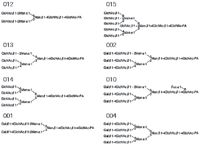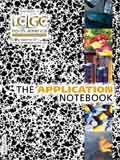Separation of Glycans by Shodex™ NH2P Amino HILIC Column
In this application, we present the feasibility of NH2P-50 4E, polymer-based amino HILIC column, for the structure analysis of N-glycans in biological samples. Characterization of glycan is important since different biological properties of glycoprotein play unique roles on pharmacokinetics, stability, and antigenicity.
In this application, we present the feasibility of NH2P-50 4E, polymer-based amino HILIC column, for the structure analysis of N-glycans in biological samples. Characterization of glycan is important since different biological properties of glycoprotein play unique roles on pharmacokinetics, stability, and antigenicity.
A mixture of eight different N-glycans modified with 2-aminopyridine (PA) was used as a test sample. Pyridylamino derivatization is one of the common labelings used for the analysis of very low-concentration glycan. The method provides a detection limit of 30 fmol using a fluorescence detector (1) or even lower with a mass spectrometer (MS).

Figure 1: Separation of eight PA-sugar chain by NH2P-50 4E. Eluent; (A) CH3CN (B) 200 mM Acetic acid (pH 7.3) Gradient A/B = 65/35 to A/B = 50/50 over 60 min. Flow rate; 0.5 mL/min, Temp.; 40 °C, Detector; Florescence detector (Ex: 310 nm, Em: 380 nm). Sample PA-sugar chain stds: 0.125 pmol/µL each, 5 µL. 1: Std.012, 2: Std.013, 3: Std.014, 4: Std.001, 5: Std.015, 6: Std.002, 7: Std.010, 8: Std.004.
Various LC separation modes have been developed for glycan analysis. HILIC mode is one of the separation modes generally used in combination with others: Because of the complexity and the diversity of glycans possibly present in a biological sample, multiple separation modes are often required.
Experimental Conditions
Separation was carried by Asahipak NH2P-50 4E (4.6 × 250 mm, 5 µm); column heated at 40 °C and flow rate at 0.5 mL/min. A mixture of (A) acetonitrile and (B) 200 mM acetic acid (pH = 7.3, pH adjusted by triethylamine) was used as a mobile phase. The linear gradient method was programmed from A/B = 65/35 to A/B = 50/50 over 60 min. Sample contained 0.125 pmol/µL each of eight different PA-sugar chain standards (Takara Bio Inc., Otsu, Shiga, Japan), diluted with mobile phase (A/B = 65/35). Injection volume of 5 µL was used for the experiment. A fluorescence detector was used for the measurement using excitation wavelength at 310 nm and emission wavelength at 380 nm.

Figure 2: Structures of PA-sugar chain analyzed in this study.
Results
Good separation was obtained for most PA-sugar chains that were analyzed. The PA-sugar chains were separated based on their structure differences. A baseline separation was not achieved for PA-sugar chain 001 and 014, however the structure analysis can be completed if a MS was used as a detector in place of fluorescence detector.
NH2P series column is available in different sizes. Our newest member of the series, NH2P-40 3E (3.0 × 250 mm, 4 µm) can be used with a conventional HPLC system with improved resolution, while NH2P-50 2D (2.0 × 150 mm, 5 µm) is recommended for MS analysis.
In addition to the PA labeled sugar chains, the NH2P series column is also appropriate for the separation of sugar chains modified with other labels: N-glycans in Human IgG, labeled with 2-aminobenzoic acid (2AA) were separated using NH2P40-2D (2.0 × 150 mm, 4 µm) (Data available in Shodex™ catalog).
Conclusions
Shodex™ polymer-based amino HILIC column, NH2P-50 4E, can be used to separate selected N-glycans modified with fluorescent label. The method provides femtomole level analysis of N-glycans with a fluorescence detector.
References
(1) Takara Bio Inc. html:/catalog.takara-bio.co.jp.
Shodex™/Showa Denko America, Inc.
420 Lexington Avenue Suite 2850, New York, NY, 10170
Tel.: (212) 370-0033 x109, fax: (212) 370-4566
Website: www.shodex.net

SEC-MALS of Antibody Therapeutics—A Robust Method for In-Depth Sample Characterization
June 1st 2022Monoclonal antibodies (mAbs) are effective therapeutics for cancers, auto-immune diseases, viral infections, and other diseases. Recent developments in antibody therapeutics aim to add more specific binding regions (bi- and multi-specificity) to increase their effectiveness and/or to downsize the molecule to the specific binding regions (for example, scFv or Fab fragment) to achieve better penetration of the tissue. As the molecule gets more complex, the possible high and low molecular weight (H/LMW) impurities become more complex, too. In order to accurately analyze the various species, more advanced detection than ultraviolet (UV) is required to characterize a mAb sample.

.png&w=3840&q=75)

.png&w=3840&q=75)



.png&w=3840&q=75)



.png&w=3840&q=75)














